
Over the last few years, the video has overtaken the internet. In 2 years’ time, it’s expected that 4 out of 5 online sessions will be strictly video. As more and more marketers use it to communicate, video proved its power not only when it comes to traffic and retention, but with sales as well. As video proved itself valuable in closing sales, a new trend emerged: shoppable video. Shoppable video content represents the experience that allows viewers to buy products straight from a video stream.
While we were forced to stay at home, video consumption saw an incredible rise. Both Facebook and Instagram saw considerable increases in live viewing – more than 50%.
For commerce, it was only normal to see a massive increase in online shopping. As we were unable to leave our homes for long periods of time, most of our shopping was done online. But human interaction was lacking and customers were looking for experiences that have a personal touch. This is how shoppable video content gained ground.
Shoppable video content should be fun
What makes shoppable video unique is that it combines shopping and entertainment in ways previously seen just during the in-person experiences. The result, “shoppertainment”, is closer to experiential marketing that it is to e-commerce. Because just like we naturally developed “banner blindness” (the natural ad blocker) it’s expected that we will soon start to naturally ignore hard sales through video as well. Shoppertainment is a consumer-centric experience, not product-centric, where the focus is on helping viewers better understand how the products look and feel. The aim is to create an enjoyable experience that encourages your viewers to buy – not to sell them the products.<.p>
Authenticity is important
Not just in sales, but in any activity that we perform. Authenticity is reasonably the main driver that triggers engagement and loyalty. This is one of the many reasons shoppable video sessions are so popular – they are live, unedited, and showcase the products exactly how they are. Customers know that they are engaging a real person and getter a better sense of your products, therefore they are more inclined to buy.
Authenticity is crucial, so who could be better at this than somebody that knows the products and already showcased them in front of potential customers? As retail businesses were forced to close their brick and mortar shops due to Covid 19 related restrictions, millions of store assistants had their jobs affected. But live stream shopping could help them use their experience even if stores are closed.
Don’t take shortcuts when it comes to video quality
Customers appreciate an authentic experience that has its natural flows. But they won’t appreciate the lack of quality in your shoppable video experience. 60% of viewers will gain a negative perception of your brand when interacting with poor quality video. Before going live check your camera, lights, and microphone. Otherwise, people will consider leaving your brand and following your competitors.

Encourage engagement
While live, encourage people to chat and ask questions. This will offer you a great opportunity to see what people are interested in, what they expect from your products, and what are their concerns. Over 85% of consumers have at least one question they need to find an answer to before purchasing a product. By answering questions live, you will help not just the one that has asked it, but other viewers as well.
Another reason to encourage viewers to engage through chat is that user-generated content is perfect for enhancing the customer experience. Let existing customers share their past experiences with your brand and products. As the vast majority of millennials find UGC a very good indicator of a brand’s quality, encouraging engagement for your shoppable video content will be gain you live testimonials.

Final thoughts
Marketers are using video to connect viewers and brands. It’s proven itself as a valuable asset. But shoppable video content goes one step further: it allows your customers to benefit from a retail-like experience. From the conform of their homes.
Treat your online viewers just like you are treating your in-store clients. By engaging them and answering their questions you will transform them into customers. But more than that, you will make them feel like part of your community.





